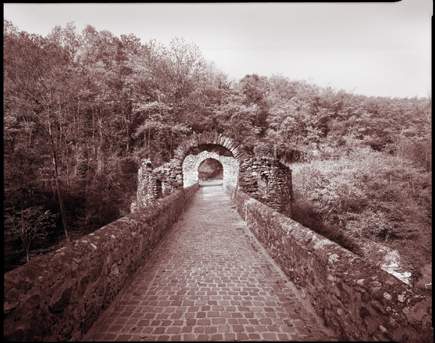The Fotoman 810PS; Yes, The PS Stands For Point-And-Shoot! Page 2
The camera is indeed hand holdable, and there are many assignments where it would make sense to hand hold it. One of the custom 8x10s mentioned earlier was used for shooting London from a boat sailing down the Thames, for example. On the other hand, I found it much easier and more convenient to use either a monopod (your arms get tired from holding up 10 lbs/4.5 kg of camera) or even a lightweight tripod. Because the camera is so simple, and designed to be handheld, you can get away with a very light tripod indeed. I used an old wooden MPP tripod that weighs under 21¼2 lbs, around a kilo, complete with head.
At this point, another question comes up. If you are going to use a tripod, why not use a "real" 8x10" camera with movements? The answers are simple: weight, speed, and toughness. The 810PS and a light tripod are a lot lighter than almost any conventional 8x10; the camera is very quick to use, not least because it requires no setting up of bellows and the like; and its toughness was proved at photokina, before I picked it up for review, when it was knocked over and fell several feet onto the floor.
 |
|
|
If you are using it handheld, it makes sense to load it with something like
Ilford HP5 Plus processed in Ilford DD-X, which gives you a true ISO of 650
or a little better. Then, you can shoot at f/11, f/16, or f/22 in the interests
of depth of field while still retaining a reasonable shutter speed.
Remember, though, that the bigger the negative, the smaller the degree of enlargement,
and the longer the shutter speed you can safely hand hold. This is how the pressmen
of yore used to get away with 1/10 and 1/5 sec and longer with their 5"
(127mm) lenses on 4x5" Speed Graphics. How long you can hand hold the
810PS will depend on many variables, including how tired your arms are from
holding it up, but 1¼30 sec or longer should be feasible most of the
time.
As it was, I used Ilford FP4 Plus, partly because I was using a monopod or tripod
most of the time, and partly because I prefer the tonality of FP4 for contact
prints--though strangely enough, I prefer the tonality of HP5 Plus for
enlargements.
The camera accepts standard 8x10" film holders, though as already noted,
they don't slip under the ground glass: you have to pull it out. Also,
you have to be careful at first when slipping the holders in, because you can
push them too far. This puts them slightly out of alignment and off-center,
and makes the dark slides hard to pull out. Once you realize what the problem
is, you can stop as soon as you feel the rib on the holder engage with the slot
in the back; but you need to be aware of it.
There is not much else to say. I have to admit that, initially, I was not especially
enamored of the concept of the 810PS: it seemed like a lot of trouble to go
to, whether you are talking about the bulk, weight, and expense of the camera
itself, or the sheer hassle of processing 8x10" sheet film--I used
a Paterson Orbital processor. (To learn more about this, visit the free "How
Do I...?" module of The Photo School at www.rogerandfrances.com.)
Then I saw those huge, tonally lovely negatives, and I revised my opinion considerably.
I managed to give the camera back, but not without regrets. As so often with
Fotoman products, I seriously wondered about how much money they would want,
if I wanted to keep it.
The MSRP for the Fotoman 810PS as a complete kit is $1249.95. The complete kit
includes the camera body, cone assembly for lenses up to 155mm, helical focus
mount (Copal 0 or Copal 1), optical viewfinder, insertable ground glass, dual-axis
bubble level, shutter release cable, and an aluminum carrying case.
For more information, contact Fotoman's US distributors, Badger Graphic
Sales, Inc. (1225 Delanglade St., Kaukauna, WI 54130; (920) 766-9332; www.badgergraphic.com)
and Midwest Photo Exchange (3313 North High St., Columbus, OH 43202; (614) 261-1264;
www.mpex.com).
For further information on the art and craft of photography from Roger Hicks
and Frances Schultz, go to www.rogerandfrances.com.
- Log in or register to post comments

































